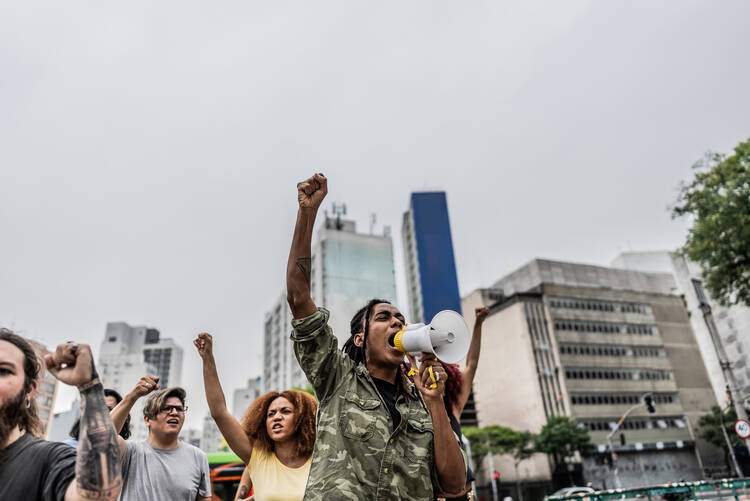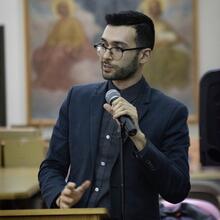A wide variety of evangelizing efforts have set out to make the church more relevant to young people. A new book by the sociologist Musa al-Gharbi is essential reading for those engaged in these ministries.
We Have Never Been Woke sets out to document the broader historical and sociological implications of our current waves of “wokeness” and “anti-wokeness.” Unlike many other books on this topic, it is neither ideological nor reactionary. It seeks to untangle and differentiate competing threads of discourse around identity and social justice.
The author frames his research through the work of French sociologist Pierre Bourdieu, from whom Al-Gharbi borrows the category of “symbolic capitalists.” He describes symbolic capitalists as “professionals who traffic in symbols and rhetoric, images and narratives, data and analysis, ideas and abstraction.” Take, for example, the work of educators, lawyers, journalists, social workers and engineers, all centered around various modes of communication. Their work sets the terms of ideas and discourse for the public.
Because their worldview is dominated by abstractions, the changes that symbolic capitalists propose tend to be more “symbolic” in nature (“representation,” filling minority quotas, speech codes) than concrete (increase in pay, right to unionize, employee benefits). Symbolic capitalists fail to do very much to afford working class communities adequate legal and economic protections in order to live a more stable life. They claim to be progressive and to care about the oppressed. In reality they are more focused on procuring their own material security. Thus, al-Gharbi claims, they are not, and never have been, “woke.”
One of the key examples that al-Gharbi uses to demonstrate his point is the Occupy Movement of 2011 and 2012. A group who represented the “99%” camped out on Wall Street and in city squares all over the country, to protest the fact that the top-earning 1 percent of the population owns an inordinate amount of wealth in the United States. Though these protestors claimed to stand against corrupt “superelites,” al-Gharbi points out that most of them, though not billionaires, belonged to the social elite. They were, again, symbolic capitalists.
As I read through the book, taking copious notes in the margins, I couldn’t help but feel that al-Gharbi’s focus on the distinction between concrete and symbolic activism sheds light on the pitfalls Catholics get trapped in when attempting to communicate the church’s message.
Symbolic capitalists’ tend to look at social issues through a hyper-moralized lens. They can be overly concerned with proving themselves “on the right side of history” on issues like same-sex marriage, trans rights, reparations for slavery, police brutality and immigration. Echoing the insights of Christopher Lasch, al-Gharbi warns that projecting our moral anxieties through “virtue signaling” quickly morphs from making a real commitment to improving social conditions, to a largely sentimental attempt to affirm our sense of self-worth.
At times our church evangelizing efforts appear caught up in doing the same work of mere moralizing and feel-good sentimentality.
Throughout the centuries, plenty of saints and mystics prioritized making time for God in prayer. But it was not sentimental and abstract. They understood that—as St. Paul wrote—“if I have not love, I am a noisy gong.” Revered figures like Mother Teresa and St. Frances Cabrini understood that without a robust prayer life and devotion to the Eucharist, their attempts to serve the poor would be in vain.
They also knew that their rich inner life, cultivated in prayer, reached its fulfillment “in the flesh”—in concrete actions and initiatives that would directly respond to the needs of the underprivileged. On a secular level, Al-Gharbi reminds us that our pursuit of interior consolation should not come at the cost of failing to be pragmatic and even strategic about addressing the needs of our neighbors.
The abstractness of public discourse also makes it more tempting for us to reduce faith to simple moral platitudes. This is done by those who lean left and condemn police personnel as a whole for beating Black people, or those who lean right and call women who have abortions “murderers.” We tend to forget that talk alone is cheap. As Sohrab Ahmari recently wrote, the church recognizes that the various aspects of life are all connected. It teaches that politics and economics are not separate from faith and morals.
To find an antidote to this tendency to compartmentalize the different aspects of life, we need not look far. There have been numerous Catholic activists and organizations in recent years and decades who were involved in direct action to alleviate social ills. Take ministries and initiatives like the Catholic Worker, Mondragon Corporation, Sant’Egidio, Thrive for Life, APAC prison system, Homeboy Industries, Compagnia delle Opere and figures like Msgr. Geno Baroni and Edward J. Flanagan of Boys Town. The examples abound.
When confronting those whom society labeled as sinners, Jesus’ approach involved much more than issuing a verbal censure and then walking away. Understanding that sin rarely exists in a vacuum, Jesus’ corrections always seemed to consider the totality of circumstances that led people into sin. This includes the sexual and emotional brokenness of the women caught in adultery and the tax collectors who felt ostracized by others. Likewise, al-Gharbi’s research challenges us to consider the extent to which material conditions incite or make it more difficult for us to turn away from sinful choices.
Who can measure the effects on society if a much larger swath of people had stable, well-paid jobs and thus were better able to spend time with their families, neighbors and community members? In a culture like that, we can easily speculate that fewer people—especially children—would be drawn to lifestyle choices that contradict God’s plan for their happiness.
Further, the temptation to overt moralizing can make Catholics vulnerable to being co-opted as agents in the “culture war,” rather than agents of collaboration and unity. There is surely a time and place for taking a definitive stance on important moral issues—namely, when we find ourselves in a position to concretely challenge or change circumstances that threaten the dignity of others. And as Jesus warned us, it is inevitable that we are going to ruffle some feathers when preaching the good news.
But prudence calls for us to use discernment in the way we communicate moral truths. Taking a “symbolic” stance on an issue, writes al-Gharbi, as the “symbolic capitalists do, does not relieve us of the call to foster unity among our brethren.” When we reduce our “stances” on issues to a matter of identity or of signaling our tribal belonging, we ignore the duty to realize Jesus’ desire “that they may all be one.” Instead, our stances ought to consist of concrete gestures of charity for our neighbor, who is our brother or sister in Christ.
Talking about concrete realities tends to bring people together more than arguing about abstract issues. Especially in our polarized age, we ought to be careful not to miss out on opportunities to work together to solve problems with those we do not completely agree with. Contributing to the common good is much more important than avoiding “guilt by association” and our anxiety to prove our moral purity. We would also do well to remember the words of hip-hop artist Ms. Lauryn Hill, who once said that “it is more important to be righteous than to be right.” St. Francis of Assisi told us to preach the Gospel always, using words when necessary. And ultimately, we are stronger when united than divided.
As al-Gharbi’s brilliant book indicates, the best way to confront social problems is through direct action. The church, with its faith in the God who entered into the concrete circumstances of our everyday lives, has a special mission in our era, overrun as it is by division and empty symbolic stances. Catholic evangelizers, preachers and educators should consider the ways they can shift their focus toward inviting people to “get their hands dirty,” as Pope Francis has said, and get to work—together.








